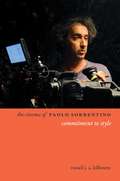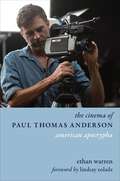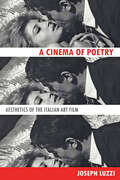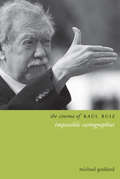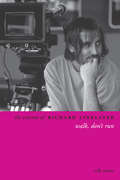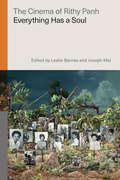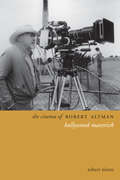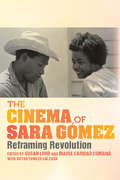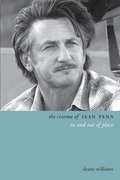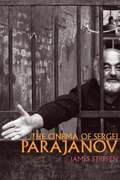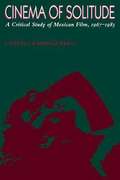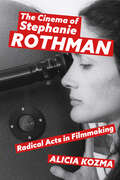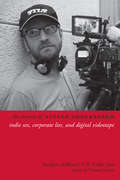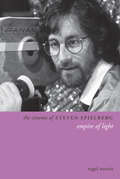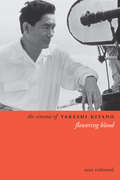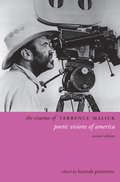- Table View
- List View
The Cinema of Paolo Sorrentino: Commitment to Style (Directors' Cuts)
by Russell KilbournPaolo Sorrentino, director of Il Divo (2008) and The Great Beauty (2013) and creator of the HBO series The Young Pope (2016), has emerged as one of the most compelling figures in twenty-first-century European film. From his earliest productions to his more recent transnational works, Sorrentino has paid homage to Italy’s cinematic past while telling stories of masculine characters whose sense of self seems to be on the brink of dissolution. Together with his usual collaborators (including cinematographer Luca Bigazzi and editor Cristiano Travagliolo) and actors (chief among them Toni Servillo), Sorrentino has produced an incisive depiction of the contemporary European condition by means of an often spectacular postclassical style that nevertheless continues postwar Italian film’s tradition of political commitment.This book is a critical examination of Sorrentino’s work, focusing on his emergence as a preeminent transnational auteur. Russell J. A. Kilbourn offers close readings of Sorrentino’s feature films and television output from One Man Up (2001) to The Young Pope (2016) and Loro (2018), featuring in-depth analyses of the director’s exuberant and intensified film style. Addressing the crucial themes of Sorrentino’s output—including a masculine subject defined by a melancholic awareness of its own imminent demise, and a critique of the conventional cinematic representation of women—Kilbourn illuminates Sorrentino’s ability to suffuse postmodern elegies for the humanist worldview with a sense of social awareness and responsibility. Kilbourn also foregrounds Sorrentino’s contributions to the ongoing transformations of cinematic realism and the Italian and European art cinema traditions more broadly. The first English-language study of the acclaimed director’s oeuvre, The Cinema of Paolo Sorrentino demonstrates why he is considered one of the most dynamic figures making films today.
The Cinema of Paul Thomas Anderson: American Apocrypha (Directors' Cuts)
by Ethan WarrenPaul Thomas Anderson’s evolution from a brash, self-anointed “Indiewood” auteur to one of his generation’s most distinctive voices has been one of the most remarkable career trajectories in recent film history. From early efforts to emulate his cinematic heroes to his increasingly singular late films, Anderson has created a body of work that balances the familiar and the strange, history and myth: viewers feel perpetually off balance, unsure of whether to expect a pitch-black joke or a moment of piercing emotional resonance.This book provides the most complete account of Anderson’s career to date, encompassing his varied side projects and unproduced material; his personal and professional relationships with directors such as Jonathan Demme, Robert Altman, and Robert Downey Sr.; and his work as a director of music videos for Fiona Apple, Joanna Newsom, and Haim. Ethan Warren explores Anderson’s recurring thematic preoccupations—the fraught dynamics of gender and religious faith, biological and found families, and his native San Fernando Valley—as well as his screenwriting methods and his relationship to his influences. Warren argues that Anderson’s films conjure up an alternate American history that exaggerates and elides verifiable facts in search of a heightened truth marked by a deeper level of emotional hyperrealism. This book is at once an unconventional primer on Anderson’s films and a provocative reframing of what makes his work so essential.
A Cinema of Poetry: Aesthetics of the Italian Art Film
by Joseph LuzziExplores the poetics and aesthetics of the Italian art film in Rossellini, Antonioni, Fellini, and other groundbreaking directors.A Cinema of Poetry brings Italian film studies into dialogue with fields outside its usual purview by showing how films can contribute to our understanding of aesthetic questions that stretch back to Homer. Joseph Luzzi considers the relation between film and literature, especially the cinematic adaptation of literary sources and, more generally, the fields of rhetoric, media studies, and modern Italian culture.The book balances theoretical inquiry with close readings of films by the masters of Italian cinema: Roberto Rossellini, Vittorio De Sica, Luchino Visconti, Michelangelo Antonioni, Federico Fellini, Pier Paolo Pasolini, Bernardo Bertolucci, and others. Luzzi's study is the first to show how Italian filmmakers address such crucial aesthetic issues as the nature of the chorus, the relation between symbol and allegory, the literary prehistory of montage, and the place of poetry in cinematic expression—what Pasolini called the "cinema of poetry." While Luzzi establishes how certain qualities of film—its link with technological processes, capacity for mass distribution, synthetic virtues (and vices) as the so-called total art—have reshaped centuries-long debates, A Cinema of Poetry also explores what is specific to the Italian art film and, more broadly, Italian cinematic history. In other words, what makes this version of the art film recognizably "Italian"?
The Cinema of Raúl Ruiz: Impossible Cartographies (Directors' Cuts)
by Michael GoddardRaúl Ruiz, while considered one of the world's most significant filmmakers by several film critics, is yet to be the subject of any thorough engagement with his work in English. This volume sets out on this task by mapping, as fully as possible, Ruiz's cinematic trajectory across more than five decades of prolific work, up to his death in 2011; ranging from his earliest work in Chile to high-budget 'European' costume dramas culminating in Mysteries of Lisbon (2010). It does so by treating Ruiz's work—with its surrealist, magic realist, popular cultural, and neo-Baroque sources—as a type of 'impossible' cinematic cartography, mapping real, imaginary, and virtual spaces, and crossing between different cultural contexts, aesthetic strategies, and technical media. It argues that across the different phases of Ruiz's work identified, there are key continuities such as the invention of singular cinematic images and the interrogation of their possible and impossible combinations.
The Cinema of Raul Ruiz
by Michael GoddardRaúl Ruiz, while considered one of the world's most significant filmmakers by several film critics, is yet to be the subject of any thorough engagement with his work in English. This volume sets out on this task by mapping, as fully as possible, Ruiz's cinematic trajectory across more than five decades of prolific work, up to his death in 2011; ranging from his earliest work in Chile to high-budget 'European' costume dramas culminating in Mysteries of Lisbon (2010). It does so by treating Ruiz's work -- with its surrealist, magic realist, popular cultural, and neo-Baroque sources -- as a type of 'impossible' cinematic cartography, mapping real, imaginary, and virtual spaces, and crossing between different cultural contexts, aesthetic strategies, and technical media. It argues that across the different phases of Ruiz's work identified, there are key continuities such as the invention of singular cinematic images and the interrogation of their possible and impossible combinations.
The Cinema of Richard Linklater: Walk, Don't Run (Directors' Cuts)
by Rob StoneFrom Slacker (1991), a foundational work of independent American cinema, to the Before trilogy, Richard Linklater’s critically acclaimed films and aesthetic ambition have earned him a place as one of the most important contemporary directors. In this second edition of The Cinema of Richard Linklater, Rob Stone shows how Linklater’s latest films have redefined our understanding of his work. He offers critical discussions and analysis of all of Linklater’s films, including Before Midnight (2013) and Everybody Wants Some!! (2016), as well as new interviews with Linklater and a chapter on Boyhood (2014), hailed as one of the best films of the twenty-first century.Stone explores the theoretical, practical, contextual, and metaphysical elements in Linklater’s filmography, especially his experimentation with cinematic representations of time and growth. He demonstrates that fanciful lives and lucid dreams are as central as alternative notions of America and time to Linklater’s films. Stone also considers Linklater’s collaborative working practices, his deployment of such techniques as rotoscoping, and his innovative distribution strategies. Thoroughly revised, updated, and extended, the book includes analysis of all of Linklater’s films, including Dazed and Confused (1993), Waking Life (2011), and A Scanner Darkly (2006) as well as his documentaries, short films, and side projects.
The Cinema of Richard Linklater: Walk, Don't Run (Directors' Cuts)
by Rob StoneFrom Slacker (1991) to The School of Rock (2003), from Before Sunrise (1995) to Before Sunset (2004), from the walking and talking of his no/low-budget American independent films to conversing with the philosophical traditions of the European art house, Richard Linklater's films are some of the most critical, political, and spiritual achievements of contemporary world cinema. Examinations of Linklater's collaborative working practices and deployment of rotoscoping and innovative distribution strategies all feature in this book, which aspires to walk and talk with the filmmaker and his films. Informed by a series of original interviews with the artist, in both his hometown and frequent film location of Austin, Texas, this study of the director who made Dazed and Confused (1993), A Scanner Darkly (2006), and Bernie (2011) explores the theoretical, practical, contextual, and metaphysical elements of these works along with his documentaries and side-projects and finds fanciful lives and lucid dreams have as much to do with his work as generally alternative notions of America, contemporary society, cinema, and time.Â
The Cinema of Richard Linklater: Walk, Don't Run
by Rob StoneFrom Slacker (1991) to The School of Rock (2003), from Before Sunrise (1995) to Before Sunset (2004), from the walking and talking of his no/low-budget American independent films to conversing with the philosophical traditions of the European art house, Richard Linklater's films are some of the most critical, political, and spiritual achievements of contemporary world cinema. Examinations of Linklater's collaborative working practices and deployment of rotoscoping and innovative distribution strategies all feature in this book, which aspires to walk and talk with the filmmaker and his films. Informed by a series of original interviews with the artist, in both his hometown and frequent film location of Austin, Texas, this study of the director who made Dazed and Confused (1993), A Scanner Darkly (2006), and Bernie (2011) explores the theoretical, practical, contextual, and metaphysical elements of these works along with his documentaries and side-projects and finds fanciful lives and lucid dreams have as much to do with his work as generally alternative notions of America, contemporary society, cinema, and time.
The Cinema of Rithy Panh: Everything Has a Soul (Global Film Directors)
by Leslie Barnes Joseph MaiBorn in 1964, Cambodian filmmaker Rithy Panh grew up in the midst of the Khmer Rouge’s genocidal reign of terror, which claimed the lives of many of his relatives. After escaping to France, where he attended film school, he returned to his homeland in the late 1980s and began work on the documentaries and fiction films that have made him Cambodia’s most celebrated living director. The fourteen essays in The Cinema of Rithy Panh explore the filmmaker’s unique aesthetic sensibility, examining the dynamic and sensuous images through which he suggests that “everything has a soul.” They consider how Panh represents Cambodia’s traumatic past, combining forms of individual and collective remembrance, and the implications of this past for Cambodia’s transition into a global present. Covering documentary and feature films, including his literary adaptations of Marguerite Duras and Kenzaburō Ōe, they examine how Panh’s attention to local context leads to a deep understanding of such major themes in global cinema as justice, imperialism, diaspora, gender, and labor. Offering fresh takes on masterworks like The Missing Picture and S-21 while also shining a light on the director’s lesser-known films, The Cinema of Rithy Panh will give readers a new appreciation for the boundless creativity and ethical sensitivity of one of Southeast Asia’s cinematic visionaries.
The Cinema of Robert Altman: Hollywod Maverick
by Robert NiemiIn a controversial and tumultuous filmmaking career that spanned nearly fifty years, Robert Altman mocked, subverted, or otherwise refashioned Hollywood narrative and genre conventions. Altman's idiosyncratic vision and propensity for formal experimentation resulted in an uneven body of work: some rank failures and intriguing near-misses, as well as a number of great films that are among the most influential works of New American Cinema. While Altman always professed to have nothing authoritative to say about the state of contemporary society, this volume surveys all of his major films in their sociohistorical context to reposition the director as a trenchant satirist and social critic of postmodern America, depicted as a lonely wasteland of fraudulent spectacle, exploitative social relations, and unfulfilled solitaries in search of elusive community.
The Cinema of Robert Altman: Hollywood Maverick (Directors' Cuts)
by Robert NiemiIn a controversial and tumultuous filmmaking career that spanned nearly fifty years, Robert Altman mocked, subverted, or otherwise refashioned Hollywood narrative and genre conventions. Altman's idiosyncratic vision and propensity for formal experimentation resulted in an uneven body of work: some rank failures and intriguing near-misses, as well as a number of great films that are among the most influential works of New American Cinema. While Altman always professed to have nothing authoritative to say about the state of contemporary society, this volume surveys all of his major films in their sociohistorical context to reposition the director as a trenchant satirist and social critic of postmodern America, depicted as a lonely wasteland of fraudulent spectacle, exploitative social relations, and unfulfilled solitaries in search of elusive community.
The Cinema of Sara Gómez: Reframing Revolution (New Directions in National Cinemas)
by Inés María Martiatu Terry Lourdes Martínez-Echazábal Odette Casamayor-Cisneros Sergio Giral Luis García Mesa Devyn Spence Benson Rigoberto López Joshua Malitsky Ana Serra Iván Arocha Montes de Oca Ricardo Acosta Alan West-Durán Sandra Abd’Allah-Alvarez RamírezThroughout the 1960s until her untimely death in 1974, Afro-Cuban filmmaker Sara Gómez engaged directly and courageously with the social, political, economic, and cultural transformations promised by the Cuban Revolution. Gómez directed numerous documentary films in 10 prolific years. She also made De cierta manera (One way or another), her only feature-length film. Her films navigate complex experiences of social class, race, and gender by reframing revolutionary citizenship, cultural memory, and political value. Not only have her inventive strategies become foundational to new Cuban cinema and feminist film culture, but they also continue to inspire media artists today who deal with issues of identity and difference. The Cinema of Sara Gómez assembles history, criticism, biography, methodology, and theory of Gómez's work in scholarly writing; interviews with friends and collaborators; the film script of De cierta manera; and a detailed and complete filmography.Featuring striking images, this anthology reorients how we tell Cuban cinema history and how we think about the intersections of race, gender, and revolution. By addressing Gómez's entire body of work, The Cinema of Sara Gómez unpacks her complex life and gives weight to her groundbreaking cinema.
The Cinema of Sean Penn
by Deane WilliamsAlthough best known as an Academy Award winning actor, Sean Penn's directorial works The Indian Runner (1991), The Crossing Guard (1995), The Pledge (2001), and Into the Wild (2007), consist of some of the most interesting and singular films made in the United States over the past twenty years. Each of Penn's directorial films and much of the cinema he has acted in are set in an immediate past in which a "stalled" time and a restricted locale apply narrative constraints. At the same time, these films all feature a sophisticated web of intertextual relations, involving actors, songs, books, films, and directors, and the political lineage to which Penn belongs, which reveal the deep cultural structures that concern each particular film.
The Cinema of Sean Penn: In and Out of Place (Directors' Cuts)
by Deane WilliamsAlthough best known as an Academy Award winning actor, Sean Penn's directorial works The Indian Runner (1991), The Crossing Guard (1995), The Pledge (2001), and Into the Wild (2007), consist of some of the most interesting and singular films made in the United States over the past twenty years. Each of Penn's directorial films and much of the cinema he has acted in are set in an immediate past in which a "stalled" time and a restricted locale apply narrative constraints. At the same time, these films all feature a sophisticated web of intertextual relations, involving actors, songs, books, films, and directors, and the political lineage to which Penn belongs, which reveal the deep cultural structures that concern each particular film.
The Cinema of Sergei Parajanov
by James SteffenSergei Parajanov (1924-90) flouted the rules of both filmmaking and society in the Soviet Union and paid a heavy personal price. An ethnic Armenian in the multicultural atmosphere of Tbilisi, Georgia, he was one of the most innovative directors of postwar Soviet cinema. Parajanov succeeded in creating a small but marvelous body of work whose style embraces such diverse influences as folk art, medieval miniature painting, early cinema, Russian and European art films, surrealism, and Armenian, Georgian, and Ukrainian cultural motifs. "The Cinema of Sergei Parajanov" is the first English-language book on the director's films and the most comprehensive study of his work. James Steffen provides a detailed overview of Parajanov's artistic career: his identity as an Armenian in Georgia and its impact on his aesthetics; his early films in Ukraine; his international breakthrough in 1964 with "Shadows of Forgotten Ancestors"; his challenging 1969 masterpiece, "The Color of Pomegranates," which was reedited against his wishes; his unrealized projects in the 1970s; and his eventual return to international prominence in the mid-to-late 1980s with "The Legend of the Surami Fortress" and "Ashik-Kerib. " Steffen also provides a rare, behind-the-scenes view of the Soviet film censorship process and tells the dramatic story of Parajanov's conflicts with the authorities, culminating in his 1973-77 arrest and imprisonment on charges related to homosexuality. Ultimately, the figure of Parajanov offers a fascinating case study in the complicated dynamics of power, nationality, politics, ethnicity, sexuality, and culture in the republics of the former Soviet Union.
Cinema of Solitude: A Critical Study of Mexican Film, 1967-1983
by Berg Charles RamírezIn thematically arranged chapters, Berg investigates the images of women, men, and social structures portrayed in New Cinema films. He finds that women characters have begun to reject traditional stereotypes for more positive images, while male characters have grown ambiguous and undefined as machismo is abandoned. Other chapters trace the continuing marginalization of Indians in Mexican culture, the changes in male dominance within the family, and the disruptive social and economic effects caused by migration.
The Cinema of Stephanie Rothman: Radical Acts in Filmmaking
by Alicia KozmaThe rare woman director working in second-wave exploitation, Stephanie Rothman (b. 1936) directed seven successful feature films, served as the vice president of an independent film company, and was the first woman to win the Directors Guild of America’s student filmmaking prize. Despite these career accomplishments, Rothman retired into relative obscurity. In The Cinema of Stephanie Rothman: Radical Acts in Filmmaking, author Alicia Kozma uses Rothman’s career as an in-depth case study, intertwining historical, archival, industrial, and filmic analysis to grapple with the past, present, and future of women’s filmmaking labor in Hollywood. Understanding second-wave exploitation filmmaking as a transitory space for the industrial development of contemporary Hollywood that also opened up opportunities for women practitioners, Kozma argues that understudied film production cycles provide untapped spaces for discovering women’s directorial work. The professional career and filmography of Rothman exemplify this claim. Rothman also serves as an apt example for connecting the structure of film histories to the persistent strictures of rhetorical language used to mark women filmmakers and their labor. Kozma traces these imbrications across historical archives. Adopting a diverse methodological approach, The Cinema of Stephanie Rothman shines a needed spotlight on the problems and successes of the memorialization of women’s directorial labor, connecting historical and contemporary patterns of gendered labor disparity in the film industry. This book is simultaneously the first in-depth scholarly consideration of Rothman, the debut of the most substantive archival materials collected on Rothman, and a feminist political intervention into the construction of film histories.
The Cinema of Steven Soderbergh: Indie Sex, Corporate Lies, and Digital Videotape (Directors' Cuts)
by Andrew deWaard R. Colin TaitThe industry's only director-cinematographer-screenwriter-producer-actor-editor, Steven Soderbergh is contemporary Hollywood's most innovative and prolific filmmaker. A Palme d'or and Academy Award-winner, Soderbergh has directed nearly thirty films, including political provocations, digital experiments, esoteric documentaries, global blockbusters, and a series of atypical genre films. This volume considers its slippery subject from several perspectives, analyzing Soderbergh as an expressive auteur of art cinema and genre fare, as a politically-motivated guerrilla filmmaker, and as a Hollywood insider. Combining a detective's approach to investigating the truth with a criminal's alternative value system, Soderbergh's films tackle social justice in a corporate world, embodying dozens of cinematic trends and forms advanced in the past twenty-five years. His career demonstrates the richness of contemporary American cinema, and this study gives his complex oeuvre the in-depth analysis it deserves.
The Cinema of Steven Soderbergh: Indie Sex, Corporate Lies, and Digital Videotape
by R. Colin Tait Dewaard AndrewThe industry's only director-cinematographer-screenwriter-producer-actor-editor, Steven Soderbergh is contemporary Hollywood's most innovative and prolific filmmaker. A Palme d'or and Academy Award-winner, Soderbergh has directed nearly thirty films, including political provocations, digital experiments, esoteric documentaries, global blockbusters, and a series of atypical genre films. This volume considers its slippery subject from several perspectives, analyzing Soderbergh as an expressive auteur of art cinema and genre fare, as a politically-motivated guerrilla filmmaker, and as a Hollywood insider. Combining a detective's approach to investigating the truth with a criminal's alternative value system, Soderbergh's films tackle social justice in a corporate world, embodying dozens of cinematic trends and forms advanced in the past twenty-five years. His career demonstrates the richness of contemporary American cinema, and this study gives his complex oeuvre the in-depth analysis it deserves.
The Cinema of Steven Spielberg: Empire of Light (Directors' Cuts)
by Nigel MorrisCinema's most successful director is a commercial and cultural force demanding serious consideration. Not just triumphant marketing, this international popularity is partly a function of the movies themselves. Polarised critical attitudes largely overlook this, and evidence either unquestioning adulation or vilification-often vitriolic-for epitomising contemporary Hollywood. Detailed textual analyses reveal that alongside conventional commercial appeal, Spielberg's movies function consistently as a self-reflexive commentary on cinema. Rather than straightforwardly consumed realism or fantasy, they invite divergent readings and self-conscious spectatorship which contradict assumptions about their ideological tendencies. Exercising powerful emotional appeal, their ambiguities are profitably advantageous in maximising audiences and generating media attention.
The Cinema of Steven Spielberg
by Nigel MorrisCinema's most successful director is a commercial and cultural force demanding serious consideration. Not just triumphant marketing, this international popularity is partly a function of the movies themselves. Polarised critical attitudes largely overlook this, and evidence either unquestioning adulation or vilification& mdash;often vitriolic& mdash;for epitomising contemporary Hollywood. Detailed textual analyses reveal that alongside conventional commercial appeal, Spielberg's movies function consistently as a self-reflexive commentary on cinema. Rather than straightforwardly consumed realism or fantasy, they invite divergent readings and self-conscious spectatorship which contradict assumptions about their ideological tendencies. Exercising powerful emotional appeal, their ambiguities are profitably advantageous in maximising audiences and generating media attention.
The Cinema of Takeshi Kitano: Flowering Blood (Directors' Cuts)
by Sean RedmondThe Cinema of Takeshi Kitano: Flowering Blood is a detailed aesthetic, Deleuzian, and phenomenological exploration of Japan's finest currently-working film director, performer, and celebrity. The volume uniquely explores Kitano's oeuvre through the tropes of stillness and movement, becoming animal, melancholy and loss, intensity, schizophrenia, and radical alterity; and through the aesthetic temperatures of color, light, camera movement, performance and urban and oceanic space. In this highly original monograph, all of Kitano's films are given due consideration, including A Scene at the Sea (1991), Sonatine (1993), Dolls (2002), and Outrage (2010).
The Cinema of Takeshi Kitano: Flowering Blood
by Sean RedmondThe Cinema of Takeshi Kitano: Flowering Blood is a detailed aesthetic, Deleuzian, and phenomenological exploration of Japan's finest currently-working film director, performer, and celebrity. The volume uniquely explores Kitano's oeuvre through the tropes of stillness and movement, becoming animal, melancholy and loss, intensity, schizophrenia, and radical alterity; and through the aesthetic temperatures of color, light, camera movement, performance and urban and oceanic space. In this highly original monograph, all of Kitano's films are given due consideration, including A Scene at the Sea (1991), Sonatine (1993), Dolls (2002), and Outrage (2010).
The Cinema of Terrence Malick: Poetic Visions of America (Directors' Cuts)
by Hannah PattersonWith 2005's acclaimed and controversial The New World, one of cinema's most enigmatic filmmakers returned to the screen with only his fourth feature film in a career spanning thirty years. While Terrence Malick's work has always divided opinion, his poetic, transcendent filmic language has unquestionably redefined modern cinema, and with a new feature scheduled for 2008, contemporary cinema is finally catching up with his vision. This updated second edition of The Cinema of Terrence Malick: Poetic Visions of America charts the continuing growth of Malick's oeuvre, exploring identity, place, and existence in his films. Featuring two new original essays on his latest career landmark and extensive analysis of The Thin Red Line-Malick's haunting screen treatment of World War II-this is an essential study of a visionary poet of American cinema.
The Cinema of Terrence Malick
by Hannah PattersonWith 2005's acclaimed and controversial The New World, one of cinema's most enigmatic filmmakers returned to the screen with only his fourth feature film in a career spanning thirty years. While Terrence Malick's work has always divided opinion, his poetic, transcendent filmic language has unquestionably redefined modern cinema, and with a new feature scheduled for 2008, contemporary cinema is finally catching up with his vision. This updated second edition of The Cinema of Terrence Malick: Poetic Visions of America charts the continuing growth of Malick's oeuvre, exploring identity, place, and existence in his films. Featuring two new original essays on his latest career landmark and extensive analysis of The Thin Red Line& mdash;Malick's haunting screen treatment of World War II-this is an essential study of a visionary poet of American cinema.
